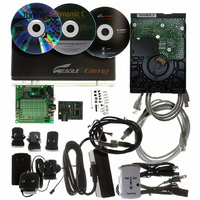101-1218 Rabbit Semiconductor, 101-1218 Datasheet - Page 53

101-1218
Manufacturer Part Number
101-1218
Description
KIT APPLCTN RABBITCORE RCM4010
Manufacturer
Rabbit Semiconductor
Series
RabbitCore®r
Datasheet
1.20-101-1094.pdf
(130 pages)
Specifications of 101-1218
Main Purpose
*
Embedded
*
Utilized Ic / Part
RCM4010
Primary Attributes
*
Secondary Attributes
*
Processor To Be Evaluated
Rabbit 4000
Interface Type
Ethernet
Operating Supply Voltage
12 V
Lead Free Status / RoHS Status
Not applicable / Not applicable
Other names
316-1156
- Current page: 53 of 130
- Download datasheet (809Kb)
5.2 Dynamic C Function Calls
5.2.1 Digital I/O
The RCM4000 was designed to interface with other systems, and so there are no drivers
written specifically for the I/O. The general Dynamic C read and write functions allow
you to customize the parallel I/O to meet your specific needs. For example, use
to set all the Port E bits as inputs, or use
to set all the Port E bits as outputs.
When using the auxiliary I/O bus on the Rabbit 4000 chip, add the line
to the beginning of any programs using the auxiliary I/O bus.
The sample programs in the Dynamic C
examples.
5.2.2 Serial Communication Drivers
Library files included with Dynamic C provide a full range of serial communications sup-
port. The
PACKET.LIB
by the 9th bit, by transmission gaps, or with user-defined special characters. Both libraries
provide blocking functions, which do not return until they are finished transmitting or
receiving, and nonblocking functions, which must be called repeatedly until they are fin-
ished, allowing other functions to be performed between calls. For more information, see
the Dynamic C Function Reference Manual and Rabbit’s Technical Note TN213, Rabbit
Serial Port Software.
5.2.3 SRAM Use
The RCM4000 module has a battery-backed data SRAM. Dynamic C provides the
protected
SRAM. Such a variable is protected against loss in case of a power failure or other system
reset because the compiler generates code that creates a backup copy of a protected variable
before the variable is modified. If the system resets while the protected variable is being
modified, the variable's value can be restored when the system restarts. This operation
requires battery-backed RAM and the main system clock. If you are using the 32 kHz
clock you must switch back to the main system clock to use protected variables because
the atomicity of the write cannot be ensured when the 32 kHz clock is being used.
User’s Manual
WrPortI(PEDDR, &PEDDRShadow, 0x00);
WrPortI(PEDDR, &PEDDRShadow, 0xFF);
#define PORTA_AUX_IO
RS232.LIB
keyword to identify variables that are to be placed into the battery-backed
library provides packet-based serial functions where packets can be delimited
library provides a set of circular-buffer-based serial functions. The
// required to enable auxiliary I/O bus
SAMPLES/RCM4000
folder provide further
47
Related parts for 101-1218
Image
Part Number
Description
Manufacturer
Datasheet
Request
R

Part Number:
Description:
COMPUTER SNGLBD BL2120 FRCTNLOCK
Manufacturer:
Rabbit Semiconductor
Datasheet:

Part Number:
Description:
KIT MESH NETWORK ADD-ON RCM4510W
Manufacturer:
Rabbit Semiconductor
Datasheet:

Part Number:
Description:
KIT DEV FOR BL2500 COYOTE
Manufacturer:
Rabbit Semiconductor
Datasheet:

Part Number:
Description:
KIT APPLICATION SIMPLE SENSOR
Manufacturer:
Rabbit Semiconductor
Datasheet:

Part Number:
Description:
KIT ETHERNET INT'L RCM3720
Manufacturer:
Rabbit Semiconductor
Datasheet:

Part Number:
Description:
KIT SERIAL-ETHERNET APPLICATION
Manufacturer:
Rabbit Semiconductor

Part Number:
Description:
KIT APPLICATION MULTI-PORT S2E
Manufacturer:
Rabbit Semiconductor

Part Number:
Description:
KIT WEB SECURE EMBEDDED RCM3700
Manufacturer:
Rabbit Semiconductor
Datasheet:

Part Number:
Description:
MODULE RABBITCORE RCM3720
Manufacturer:
Rabbit Semiconductor
Datasheet:

Part Number:
Description:
MODULE RABBITCORE RCM3220
Manufacturer:
Rabbit Semiconductor
Datasheet:

Part Number:
Description:
MODULE RABBITCORE RCM3210
Manufacturer:
Rabbit Semiconductor
Datasheet:

Part Number:
Description:
COMPUTER SGL-BOARD OP6600 W/SRAM
Manufacturer:
Rabbit Semiconductor
Datasheet:

Part Number:
Description:
COMPUTER SGL-BD BL2000 SRAM/FLSH
Manufacturer:
Rabbit Semiconductor










